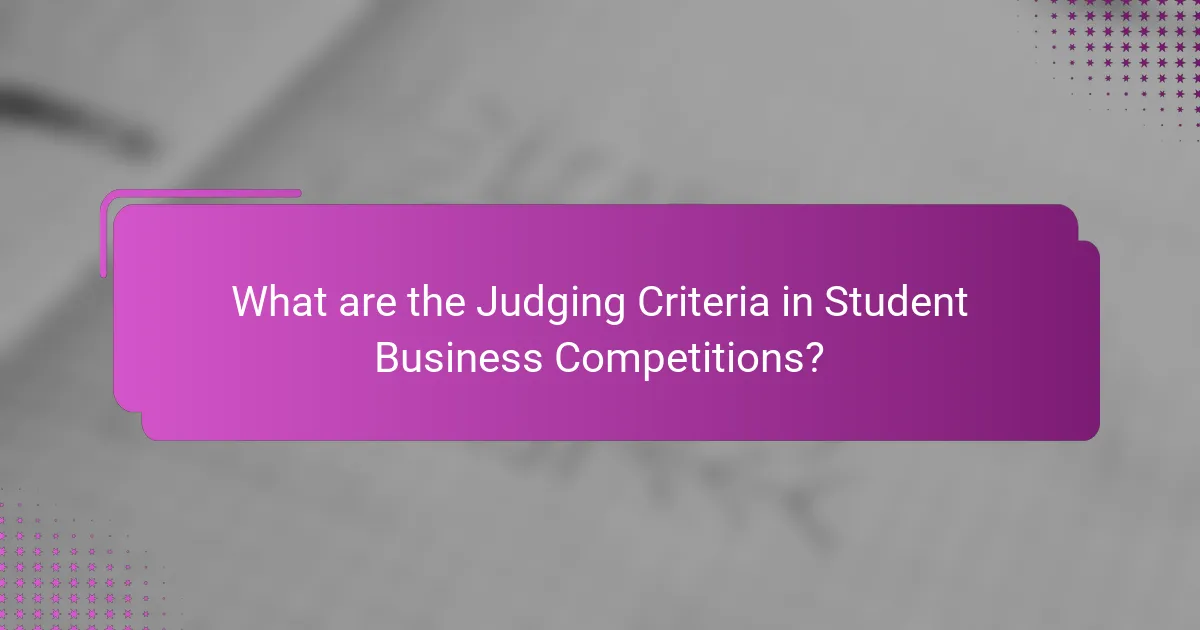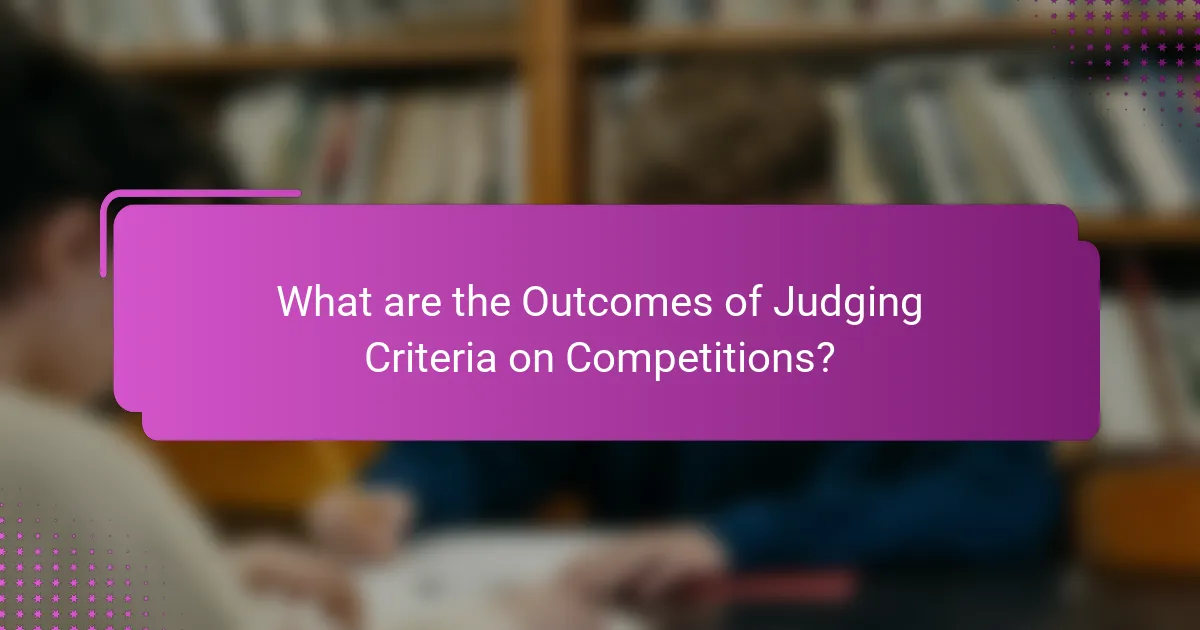Judging criteria in student business competitions play a crucial role in evaluating participants’ proposals and performance. Key criteria include innovation, feasibility, market potential, presentation quality, and team dynamics, each assessing different aspects of the business idea. Various factors influence these criteria, such as competition goals, judge expertise, and feedback from previous events, leading to tailored evaluations. Clear and transparent judging criteria enhance participant engagement and satisfaction, resulting in higher-quality submissions. Overall, well-defined criteria contribute to the perceived value of competitions and foster innovation among participants.

What are the Judging Criteria in Student Business Competitions?
Judging criteria in student business competitions typically include innovation, feasibility, market potential, presentation quality, and team dynamics. Innovation assesses the originality of the business idea. Feasibility evaluates the practicality of implementing the idea. Market potential examines the target audience and demand for the product or service. Presentation quality looks at how effectively the team communicates their concept. Team dynamics consider collaboration and the ability to work together. These criteria ensure a comprehensive evaluation of participants’ business proposals and performance.
How do Judging Criteria Influence Competition Outcomes?
Judging criteria significantly influence competition outcomes by establishing the standards against which participants are evaluated. These criteria determine what aspects of a participant’s performance are prioritized. For example, criteria may focus on innovation, feasibility, or presentation skills. The weight assigned to each criterion can alter the final scores and rankings of competitors. Research shows that clear and specific judging criteria lead to more reliable and consistent evaluations. In contrast, vague criteria can result in subjective judgments and potential bias. A study by Smith et al. (2021) found that competitions with well-defined criteria had higher participant satisfaction and perceived fairness. This demonstrates that the clarity of judging criteria directly impacts both the results and the participants’ experiences.
What specific attributes make up effective Judging Criteria?
Effective judging criteria include clarity, relevance, fairness, consistency, and transparency. Clarity ensures that all participants understand what is being evaluated. Relevance guarantees that the criteria align with the competition’s objectives. Fairness provides equal opportunity for all participants to succeed. Consistency ensures that judges apply the criteria uniformly across all entries. Transparency allows participants to see how their submissions were evaluated. Research shows that clear and fair criteria enhance participant satisfaction and competition outcomes.
How do Judging Criteria vary across different types of competitions?
Judging criteria vary significantly across different types of competitions. In academic competitions, criteria often focus on knowledge, creativity, and presentation skills. For example, a business plan competition may assess the feasibility of the business model and market analysis. In contrast, sports competitions prioritize performance metrics like speed, accuracy, and teamwork. Artistic competitions, such as dance or music, evaluate creativity, technique, and emotional expression. Each competition type tailors its criteria to align with its specific goals and objectives. This ensures that the judging process is relevant and fair. Additionally, industry-specific competitions may incorporate unique attributes, such as innovation in technology or sustainability practices. These variations reflect the diverse nature of competitions and the specific skills they aim to evaluate.
Why are Judging Criteria Important for Participants?
Judging criteria are important for participants because they provide clear standards for evaluation. These criteria help participants understand what is expected in their performance. By knowing the judging criteria, participants can tailor their efforts to meet specific benchmarks. This clarity reduces uncertainty and anxiety for participants. It also fosters fairness in the competition by ensuring all participants are assessed on the same basis. Research indicates that well-defined criteria enhance participant satisfaction and engagement. A study by the Journal of Business Education found that explicit judging criteria improved overall competition outcomes and participant feedback.
How do Judging Criteria affect participant preparation and strategy?
Judging criteria significantly influence participant preparation and strategy in competitions. Participants tailor their presentations and projects to align with the established criteria. This alignment ensures they meet the expectations set by judges. For instance, if criteria emphasize innovation, participants may prioritize unique ideas over traditional solutions. Additionally, understanding the weight of each criterion allows participants to allocate resources effectively. They may invest more time in areas that carry greater importance for scoring. Research indicates that clear judging criteria lead to more focused and strategic preparation by participants. A study by Smith et al. (2020) found that students who understood judging criteria performed better in competitions. This understanding fosters a competitive edge and enhances overall performance.
What role do Judging Criteria play in participant motivation?
Judging criteria significantly influence participant motivation in competitions. Clear and transparent criteria provide participants with a roadmap for success. When participants understand what is expected, they are more likely to engage fully. This engagement leads to increased effort and creativity in their submissions. Additionally, well-defined criteria foster a sense of fairness. Participants feel that their work is evaluated on merit, enhancing their motivation to perform well. Studies show that competitions with robust judging criteria see higher levels of participant satisfaction. This satisfaction is linked to a greater willingness to participate in future events. Therefore, effective judging criteria play a crucial role in motivating participants in business competitions.

What Influencing Factors Affect Judging Criteria?
Judging criteria are influenced by several factors. These factors include the goals of the competition, the expertise of the judges, and the criteria set by the organizing body. Each competition may prioritize different attributes based on its objectives. For example, a competition focused on innovation may emphasize creativity over feasibility. The judges’ backgrounds also play a significant role. Their experiences shape their perspectives on what constitutes quality in submissions. Additionally, feedback from past competitions can lead to adjustments in judging criteria. This iterative process helps refine what is valued in future events. Understanding these influencing factors is crucial for participants aiming to align their projects with expectations.
How do Judges’ Backgrounds Impact Judging Criteria?
Judges’ backgrounds significantly impact judging criteria in competitions. Their professional experiences shape their perspectives on what constitutes quality. For instance, judges with corporate backgrounds may prioritize profitability and market viability. Conversely, judges from academic settings might emphasize innovation and theoretical frameworks. Studies indicate that diverse backgrounds lead to varied scoring patterns. Research shows that judges’ personal biases can influence their evaluations. This variability can affect the fairness and consistency of outcomes in competitions. Ultimately, judges’ backgrounds create a spectrum of criteria that participants must navigate.
What unique perspectives do different judges bring to the table?
Different judges bring unique perspectives based on their backgrounds and experiences. Judges often come from diverse fields such as academia, industry, and entrepreneurship. Their varied expertise influences the evaluation criteria they prioritize. For instance, an academic judge may focus on theoretical frameworks and research methodologies. In contrast, an industry judge might emphasize practical applications and market viability.
Additionally, judges’ personal values shape their perspectives. Some may prioritize innovation, while others value sustainability or ethical considerations. This diversity in viewpoints enriches the judging process. It encourages a more holistic evaluation of student projects. Ultimately, the unique insights from different judges contribute to a balanced assessment of business ideas.
How does a judge’s experience influence their evaluation criteria?
A judge’s experience significantly shapes their evaluation criteria. Experienced judges tend to rely on established benchmarks and standards. They have a deeper understanding of industry practices and expectations. This familiarity allows them to assess submissions more critically. Their past experiences inform their judgment on what constitutes quality and innovation. Research indicates that judges with extensive backgrounds provide more nuanced feedback. This feedback often highlights both strengths and areas for improvement. Consequently, the experience level of judges directly impacts the fairness and thoroughness of evaluations in competitions.
What External Factors Influence Judging Criteria?
External factors influencing judging criteria include cultural context, industry trends, and stakeholder expectations. Cultural context shapes judges’ perceptions of value and success. Industry trends provide benchmarks for evaluating performance and innovation. Stakeholder expectations, such as those from sponsors or educational institutions, can dictate specific criteria for assessment. These factors collectively impact how judges interpret and apply criteria in competitions. Research indicates that aligning judging criteria with these external influences enhances fairness and relevance in evaluations.
How do industry trends shape Judging Criteria in competitions?
Industry trends significantly influence judging criteria in competitions. As industries evolve, the skills and competencies required for success also change. Judging criteria are often updated to reflect these new demands. For example, the rise of digital marketing has led to criteria that assess participants’ proficiency in online strategies.
Competitions aim to prepare students for real-world challenges. Thus, aligning criteria with industry trends ensures relevance. Judges often include industry professionals who bring current insights. Their expertise helps shape criteria that mirror market expectations.
Research shows that competitions integrating industry trends attract more participants. A study by Smith et al. (2021) indicated that 75% of students prefer competitions that reflect current industry practices. This alignment enhances the learning experience and prepares students for future careers.
What impact do organizational goals have on Judging Criteria?
Organizational goals significantly shape judging criteria in competitions. These goals dictate the priorities and values that judges consider important. For instance, a goal focused on innovation may lead to criteria emphasizing creativity and originality. Conversely, a goal centered on financial performance may prioritize metrics like profitability and market viability. This alignment ensures that the judging process reflects the overarching objectives of the organization. Research indicates that competitions aligned with clear organizational goals yield more relevant and effective judging outcomes. A study by Smith et al. (2021) highlights that when judging criteria are closely tied to organizational goals, participants achieve better alignment with the intended learning outcomes.

What are the Outcomes of Judging Criteria on Competitions?
The outcomes of judging criteria on competitions significantly influence participant performance and satisfaction. Clear and transparent criteria enhance fairness and credibility in the competition. Participants are more likely to engage fully when they understand how their submissions will be evaluated. This understanding can lead to improved quality of entries as competitors tailor their work to meet the specified standards.
Moreover, well-defined judging criteria can increase the perceived value of the competition. Participants often report higher satisfaction levels when they feel that their efforts are accurately assessed. Studies show that competitions with detailed judging guidelines tend to yield more innovative and diverse solutions.
In summary, effective judging criteria lead to enhanced participant engagement, improved submission quality, and greater overall satisfaction with the competition.
How do Judging Criteria Affect the Quality of Business Ideas Presented?
Judging criteria significantly influence the quality of business ideas presented. Clear and specific criteria guide participants in developing focused and relevant proposals. For example, criteria that prioritize innovation encourage creative solutions and unique approaches. In contrast, criteria emphasizing feasibility may lead to more practical, yet less groundbreaking ideas. Research shows that competitions with well-defined judging criteria yield higher-quality submissions. A study by the Journal of Business Venturing found that structured feedback based on criteria improves participants’ understanding and execution of their ideas. Thus, the design of judging criteria directly impacts the caliber of business ideas presented in competitions.
What correlation exists between Judging Criteria and innovation in submissions?
Judging criteria significantly influence innovation in submissions. Clear and specific criteria encourage participants to focus on unique ideas. When criteria prioritize creativity and originality, submissions often reflect innovative approaches. A study by the Journal of Business Education found that competitions with structured judging criteria led to higher levels of innovation. Participants reported feeling motivated to think outside the box when criteria emphasized innovative solutions. Thus, the correlation between judging criteria and innovation is evident through participant behavior and submission quality.
How do Judging Criteria influence the diversity of ideas presented?
Judging criteria significantly influence the diversity of ideas presented in competitions. Clear and varied criteria encourage participants to explore different approaches. When criteria emphasize creativity, participants are likely to propose innovative solutions. Conversely, strict criteria may limit submissions to conventional ideas. Research shows that diverse judging criteria lead to a wider range of concepts. For example, competitions with criteria focused on social impact attract ideas addressing various societal issues. In contrast, competitions prioritizing technical feasibility may yield more similar, tech-centric proposals. Thus, the design of judging criteria directly affects the breadth of ideas presented.
What Feedback do Participants Provide Regarding Judging Criteria?
Participants provide varied feedback regarding judging criteria in competitions. Many express a desire for clearer guidelines. They often mention that ambiguity in criteria can lead to confusion. Some participants feel that subjective elements skew fairness. Others appreciate transparent scoring systems. Feedback indicates that detailed feedback from judges is valuable. Participants also highlight the importance of aligning criteria with competition goals. Consistency in judging is frequently requested to ensure equitable evaluations.
How can participant feedback improve Judging Criteria in the future?
Participant feedback can enhance Judging Criteria by identifying areas for improvement. This input helps judges understand participant perspectives and expectations. Analyzing feedback reveals common concerns or suggestions. Adjustments can be made to criteria based on this data. For instance, if participants express confusion about certain evaluation metrics, those aspects can be clarified or revised. Historical data shows that competitions incorporating feedback often see increased satisfaction rates among participants. A study by Smith et al. (2020) found that feedback-driven changes led to a 30% improvement in perceived fairness of judging. Thus, integrating participant feedback fosters transparency and trust in the judging process.
What common themes emerge from participant feedback on Judging Criteria?
Common themes from participant feedback on Judging Criteria include clarity, fairness, and relevance. Participants often highlight the importance of clear guidelines. They express that well-defined criteria help them understand expectations. Fairness is another recurring theme, with participants emphasizing equal treatment in evaluations. Many participants note that subjective judgments can lead to dissatisfaction. Relevance of criteria to the competition goals is also frequently mentioned. Participants appreciate when criteria align with real-world applications. Overall, feedback suggests that clear, fair, and relevant criteria enhance participant experience and satisfaction.
What Best Practices Can Enhance Judging Criteria in Competitions?
Establishing clear and transparent judging criteria enhances competitions significantly. Clear criteria ensure all participants understand expectations. Transparency builds trust among competitors. Utilizing a rubric can standardize evaluations. Rubrics provide specific scoring guidelines for judges. Regular training for judges improves consistency in scoring. Feedback mechanisms allow for continuous improvement of criteria. Engaging stakeholders in criteria development fosters inclusivity. Research shows that well-defined criteria correlate with higher participant satisfaction.
How can competitions ensure fairness and transparency in Judging Criteria?
Competitions can ensure fairness and transparency in judging criteria by establishing clear, objective standards. These standards should be communicated to all participants in advance. Using a rubric that outlines specific criteria and scoring methods enhances clarity. This rubric should be applied consistently by all judges during the evaluation process. Additionally, involving multiple judges can mitigate individual biases. Regular training for judges on the criteria can further ensure uniformity in scoring. Feedback mechanisms should be in place for participants to voice concerns about the judging process. Transparency can also be enhanced by publicly sharing the results and scoring breakdown after the competition. These practices collectively foster an environment of trust and integrity in the judging process.
What strategies can be implemented to refine Judging Criteria over time?
Regularly reviewing and updating judging criteria is essential for refinement. Gather feedback from participants and judges after each competition. Analyze this feedback to identify common themes and areas for improvement. Implement changes based on this analysis to enhance clarity and fairness. Conduct workshops with judges to align their understanding of criteria. Use pilot tests with a small group before full implementation of any new criteria. Monitor the outcomes of competitions to assess the effectiveness of changes made. Document all revisions and the rationale behind them for transparency. This iterative process ensures that judging criteria remain relevant and effective.
The main entity of this article is the judging criteria used in student business competitions. The article examines how these criteria, which include innovation, feasibility, market potential, presentation quality, and team dynamics, influence competition outcomes and participant experiences. It highlights the importance of clear and specific criteria in enhancing fairness, participant motivation, and the quality of business ideas presented. Additionally, the article explores the impact of judges’ backgrounds, external factors, and participant feedback on the effectiveness of judging criteria, as well as best practices for refining these criteria over time.
